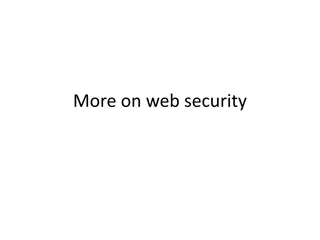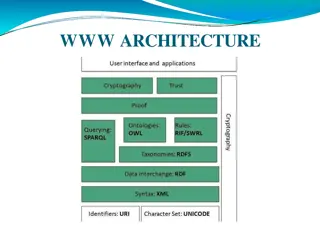Secure Web Technologies Overview
major security issues in web technologies and how to prevent unauthorized access to sensitive data through authentication and encryption methods. Exploring authentication processes like BASIC and form-based authentication, along with basic password schemes using hash functions.
Download Presentation

Please find below an Image/Link to download the presentation.
The content on the website is provided AS IS for your information and personal use only. It may not be sold, licensed, or shared on other websites without obtaining consent from the author.If you encounter any issues during the download, it is possible that the publisher has removed the file from their server.
You are allowed to download the files provided on this website for personal or commercial use, subject to the condition that they are used lawfully. All files are the property of their respective owners.
The content on the website is provided AS IS for your information and personal use only. It may not be sold, licensed, or shared on other websites without obtaining consent from the author.
E N D
Presentation Transcript
1 #07 Web Security CLIENT/SERVER COMPUTING AND WEB TECHNOLOGIES
Major security issues 2 Prevent unauthorized users from accessing sensitive data Authentication: identifying users to determine if they are one of the authorized ones Access control: identifying which resources need protection and who should have access to them Prevent attackers from stealing data from network during transmission Encryption (usually by Secure Sockets Layer)
Authentication 3 Collect user ID information from end users ( logging in ) usually by means of browser dialog / interface user ID information normally refers to username and password Transport collected user ID information to the web server unsecurely (HTTP) or securely (HTTPS = HTTP over SSL) Verify ID and passwd with backend Realms ( security database ) Realms maintain username, password, roles, etc., and can be organized by means of LDAP, RDBMS, Flat-file, etc. Validation: the web server checks if the collected user ID & passwd match with these in the realms. Keep track of previously authenticated users for further HTTP operations
BASIC Authentication 4 Is BASIC authentication good enough? Disadvantages - No customization is allowed (e.g. no user defined GUI or login pages) - Can only get username and password by default
Form-based Authentication 5 Web server collects user identification information via a customized login page, e.g.
Basic vs. Form-based 6 Basic Form-based Get username and password by using browser provided dialog box Get username and password by using a customized login page Only username and password can be collected Customized data can be collected HTTP Authentication header is used to convey username and password Form data is used to convey username and password
Basic password scheme 7 Hash function h : strings strings Given h(password), hard to find password No known algorithm better than trial and error User password stored as h(password) When user enters password System computes h(password) Compares with entry in password file No passwords stored on disk
Secure Sockets Layer (SSL) 8 A protocol developed in 1996 by Netscape for securely transmitting private web documents over the Internet. It employs private and public key to encrypt data that s transmitted over the SSL connection. By convention, URLs that require SSL connection start with https: (port 443) instead of http: (port 80). SSL is necessary if There is a login or sign in (to protect user name and passwd) It transmits sensitive data online, such as credit card information, HKID #, etc. You need to comply with privacy and security requirements
Use of an SSL Certificate 9 To enable secured SSL connections, the server needs an SSL certificate signed by a Certificate Authority (CA). CA verifies the ID of the certificate owner (e.g., www.hsbc.com.hk) when an SSL certificate is issued. Each SSL Certificate contains unique and authenticated information about the certificate owner, such as ID (in X.500 format), location, public key, and the signature of the CA. It confirms that you are who you say you are in the Internet. An SSL certificate enables encryption of sensitive information during online transactions by means of using hybrid cryptosystem.
A Sample Certificate 10 This is a certificate issued by Ace CA: Data Version: v1 (0x0) Serial Number: 1 (0x1) Signature Algorithm: PKCS #1 MD5 With RSA Encryption Issuer: OU=Ace Certificate Authority, O=Ace Ltd, C=US Validity: Not Before: Fri Nov 15 00:24:11 1996 Not After: Sat Nov 15 00:24:11 1997 Subject: CN=Jane Doe, O=Ace Industry, C=US Subject Public Key Info: Algorithm: PKCS #1 RSA Encryption Public Key: 00:d0:e5:60:7c:82:19:14:cf:38: F7:5b:f7:35:4e:14:41:2b:ec:24: 33:73:be:06:aa:3d:8b:dc:0d:06: 35:10:92:25:da:8c:c3:ba:b3:d7: lf:1d:5a:50:6f:9a:86:53:15:f2: 53:63:54:40:88:a2:3f:53:11:ec: 68:fa:e1:f2:57 Public Exponent: 65537 (0x10001) Signature Algorithm: PKCS #1 MD5 With RSA Encryption Signature: 12:f6:55:19:3a:76:d4:56:87:a6: 39:65:f2:66:f7:06:f8:10:de:cd: 1f:2d:89:33:90:3d:a7:e3:ec:27: ac:e1:c0:29:c4:5a:69:17:51:dc: 1e:0c:c6:5f:eb:dc:53:55:77:01: 83:8f:4a:ab:41:46:02:d7:c8:9a: fe:7a:91:5c
How SSL Works? 11 SSL handshake Browser connects to SSL port 443 on the web server, and Hello msg exchange btn browser & server on key-exchange, encrypt alg, etc Web server sends back its SSL certificate. Web browser decides if it wants to trust the web server s SSL certificate Web browser and web server both calculate a session key by agreed key-generation method Web Browser Web Server Web browser and web server negotiate an encryption cipher Web browser and web server exchange information encrypted by the session key and the agreed encryption algorithm
CA Root Certificate 12 Web browser needs the root certificate of the CA that issued the SSL certificate to the web-server to verify if the web server is trustable. If the browser does not have/trust the CA root certificate, most web browsers will warn you
Social Web Integration 13 In a typical web authentication model, user owning the resource shares credentials with other applications to provide them access to their protected data The above approach presents significant challenges for the resource owners It requires sharing of passwords in clear text which third party applications stores for any future use Any compromise of third party application results in compromise of user s password and its data Resource access revocation is only possible by user through password change Third party applications have full access to user s data i.e. no data level or data scope access
OAuth 14 OAuth stands for Open Authorization An open standard protocol that provides simple and secure authorization for different types of applications A simple and safe method for consumers to interact with protected data Allows providers to give access to users without any exchange of credentials Designed for use only with HTTP protocol. It does not support any other protocol
Why OAuth? 15 It is flexible, compatible and designed to work with mobile devices and desktop applications Has support from big players in the industry Facebook's Graph API Foursquare Provides a method for users to grant third-party access to their resources without sharing their credentials. Github Google Salesforce Provides a way to grant limited access in terms of scope and duration Windows Live
Introduction 16 User accesses consumer application which first gets user authenticated through API Provider application for any exchange of information Once authenticated, consumer application and Provider exchange tokens for authorization After successful authorization, consumer application gets access to users resources on Provider application Data Exchange Access API Consumer Application Provider User
Building Blocks 17 Roles Registration Tokens Authorization Flows Profiles Grants Request/Response Parameters Endpoints
Roles 18 Resource Owner Authorization Grant Request An entity referring to a system or a person (end- user) owning the resources Client An application that makes request for protected resources on behalf of Resource Owner with its authorization Authorization Server Access Token Request Server responsible for issuing access tokens to the client after successfully authenticating the resource owner and obtaining authorization Protected Resource Access Request Resource Server An entity referring to a system or a person (end- user) owning the resources The authorization server may be the same server as the resource server or a separate entity
Client Registration 19 OAuth requires Clients to register with the authorization server before making any API requests Protocol leaves the registration mechanism open to API Provider As part of registration, OAuth expects Client Type Redirections URI(s) Any other information required by API (data specific to the provider) Example: Visit http://code.google.com/apis/console https://developers.facebook.com/apps Successful registration results in issuance of credentials (Client ID & Client Secret) to client
Client Profiles 20 Server Side Web Application Client is a server hosting the client application When accessed by Resource Owner, Client Application makes API calls using appropriate programming language. Secret or access tokens are not exposed to the user Client requires repetitive access to protected resources User Agent based Application JavaScript, Flash plug-in, browser extension or any downloaded executing in browser could be OAuth client Protocol data and credentials are easily accessible (and often visible) to the resource owner There is no concern on token leakage to entrusted users or applications Native Application OAuth client is installed and executed on the resource owner s device Protocol data and credentials are accessible to resource owner Official applications released by API provider
Tokens 21 OAuth protocol supports bearer tokens. Once authorized, using bearer token client can request to access resource What is Bearer Token? A security token is something that any party in possession of the token (a "bearer") can use the token in any way that any other party in possession of it can which requiring bearer to present proof-of-possession Protocol defines two types of tokens used in the process Access Token: required to access the protected resources. Represents the grant's scope, duration, and other attributes granted by the authorization grant Refresh Token: used to obtain access tokens. Refresh tokens are issued to the client by the authorization server and are used to obtain a new access token when the current access token becomes invalid or expires etc.
Grant Types 22 Grant is a credential which represents owner s authorization and used by client to access owner s protected resources. Grant types defined by the specification Authorization Code Suited for Server Side Clients Implicit Optimized for User agent (browser) based clients Resource Owner Password Credentials Resource Owner s credentials (username/password) could be used to obtain access token. Could be used by trusted clients like mobile application Client Credentials Typically used by application to obtain access token for resources owned by the client or if there is some offline authorization agreed with an authorization server
End Points 23 Endpoints are the URIs which Client uses to make requests. Protocol supports following authorization server endpoints Authorization Endpoint Endpoint used by client to obtain resource authorization from resource owner Token Endpoint Used by client to retrieve access or refresh token Redirection Endpoint Authorization server uses the endpoint to redirect after authorization process
Authorization Flows 24 OAuth defines four authorization flows Server Side Web Application Flow User Agent (Browser) Application Flow Resource Owner Password Flow Client Credentials Flow
25 Server-Side Web Application Flow
26 Client-Side Web Applications Flow
Passport 29 Passport is authentication middleware for Node. It is designed to serve a singular purpose: authenticate requests. Single sign-on using an OAuth provider such as Facebook or Twitter has become a popular authentication method. Services that expose an API often require token- based credentials to protect access. npm install passport
Facebook as a Passport Provider 30 An app at Facebook Developers must first be created. When created, an app is assigned an App ID and App Secret. Your application must also implement a redirect URL, to which Facebook will redirect users after they have approved access for your application.
Passport Configurations 31 var passport = require('passport') , FacebookStrategy = require('passport-facebook').Strategy; passport.use(new FacebookStrategy({ clientID: FACEBOOK_APP_ID, clientSecret: FACEBOOK_APP_SECRET, callbackURL: "http://www.ex.com/auth/facebook/callback" }, function(accessToken, refreshToken, profile, done) { User.findOrCreate(..., function(err, user) { if (err) { return done(err); } done(null, user); }); })); >> npm install passport-facebook
Passport Routes 32 app.get('/auth/facebook', passport.authenticate('facebook')); app.get('/auth/facebook/callback', passport.authenticate('facebook', { successRedirect: '/', failureRedirect: '/login' } )); *without extra permissions app.get('/auth/facebook', passport.authenticate('facebook', { scope: ['read_stream', 'publish_actions'] }) ); *with multiple permissions <a href="/auth/facebook">Login with Facebook</a>
Post to Facebook 33 // Specify the URL and query string parameters needed for the request var url = 'https://graph.facebook.com/me/feed'; var params = { access_token: access_token, message: message }; // Send the request request.post({url: url, qs: params}, function(err, resp, body) { // Handle any errors that occur if (err) return console.error("Error occured: ", err); body = JSON.parse(body); if (body.error) return console.error("Error returned from facebook: ", body.error); response.send(resp); });
References 34 "Web Security Programming", Xiaohua Jia "OAuth 2.0", Amit Harsola "OAUTH 2.0", Yasmine M. Gaber "Passport: Facebook Providers", http://passportjs.org/guide/facebook/ "Post on Facebook", http://runnable.com/UTlPM1- f2W1TAABY/post-on-facebook























